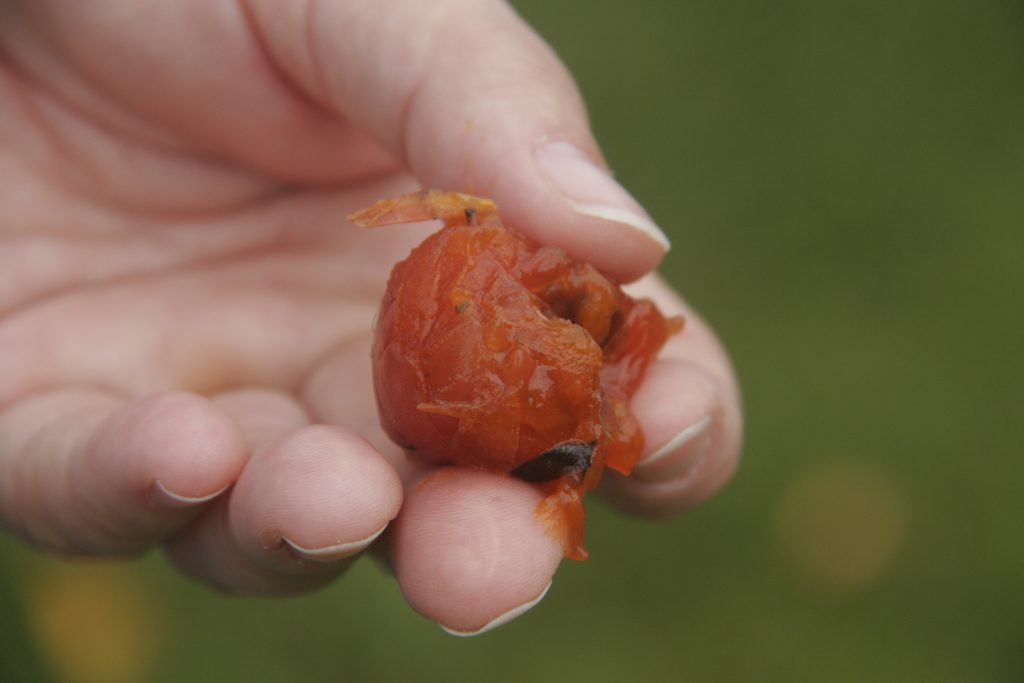
I look forward to persimmon season every year. It fills me with joy, greed, and FOMO.
You understand joy, right? These fruits are small, orange-brown balls of squishy, sweet deliciousness. There’s nothing like ’em and they make me very happy. Downright joyful.
Greed is easy, too. No one, anywhere, ever, has foraged “enough persimmons.”
FOMO is a tricky thing when it comes to persimmons. If you let it get the better of you, you’ll fill your bucket with nothing but regrets.
There are two categories of persimmons, astringent and non-astringent. Non-astringent persimmons, like the Asian Fuyu, can be eaten when they’re crisp, picked right off the tree. Astringent persimmons, like our native American persimmon, aren’t ready to eat until they actually FALL OFF THE TREE. They look and feel so soft and mushy you might think they’re rotten. Oh, but they are not.
A persimmon tree full of fruit looks like it’s been decorated for Halloween: orange balls covering its bare branches. Rumor has it persimmons can be harvested after the first frost, but don’t be fooled. A tree full of persimmons is just a tease. If you want edible fruit, look UNDER the tree.
I learned this the hard way. I was a young, innocent forager and I’ll never forget the shame I felt when I had to throw away that big bucket of unripe fruit. I tried everything to counterbalance its astringency but nothing worked. Since then I’ve read that nearly ripe persimmons can be ripened by putting them in a paper bag with either a banana or a ripe apple. Both of these fruits give off ethylene gas, which speeds the ripening process for the persimmons. But persimmons ripened this way will never have the rich, luscious sweetness of a tree-ripened persimmon.
You might wonder how bad an unripe persimmon can be. Surely I must be exaggerating. No, I’m not. An unripe persimmon is not merely sour, sharp, and unpleasant. Its astringency is so severe that it makes the inside of your mouth feel dry and fuzzy. Your eyes will squint and you’ll want to spit. On the other hand, a ripe persimmon is sublime; its pulp is silky, sweet, and tastes of caramel.
Persimmons don’t all ripen at once. Fruit on different trees can ripen months apart, and fruit on the same tree may ripen over several weeks. If you find a heavily laden tree, keep checking it every few days so you can gather the fruit as it becomes ready.
It’s perfectly alright to shake a branch to loosen ripe fruit. But taste any fruit you harvest this way to make sure it’s fully ripe. Just one unripe persimmon can ruin a whole batch of fruit.
American persimmons are smaller than their Asian counterparts, about 1 – 1.5 inches in diameter. A perfectly ripe specimen will be custardy soft and the skin will feel so thin you might expect it to break in your hand. Which it probably will. Just one more reason foraging for persimmons is so challenging. When a super soft fruit hits the ground, it often splits wide open. Only persimmons that land on soft grass or other plants remain intact. This delicate and delicious fruit makes you work for your eating pleasure.
Persimmon fruit is superb all on its own. Each fruit contains several good sized seeds, so spit them out if you’re eating the fruit plain. If you’re going to cook with the pulp, use a potato ricer or food mill to separate the seeds from the flesh. If you don’t have time to work with your persimmons at harvest time, you can freeze the pulp for later.
Steamed persimmon pudding is a classic, American dessert. It’s moist, sweet, and perfect for a holiday meal (or any meal, really). I also use persimmon pulp to make thick, cakey persimmon cookies, and yes, a frozen persimmon margarita that tastes as good as it looks. And it looks really, really good.
Leave a Reply